The first assault on East Prussia
The situation
By the beginning of September 1944, the troops of the 3 of the Belarusian Front in the course of the Belarusian Strategic Offensive Operation (Operation Bagration) reached the closest approaches to the borders of the most important German region, East Prussia. In September - October 1944, the main fighting went north, where Soviet troops carried out the Baltic offensive operation (The eighth Stalinist strike: the battle for the Baltics). Chernyakhovsky troops, in accordance with the Bids directive from 29 in August, 1944 began to equip positions along the Raseiniai-Raudane-Vilkaviskis-Lyubavas line. From the north to the south, the troops of the 39, 5, 11, Guards, 28, and 31 armies were stationed.
The German command on this 200-kilometer stretch of the Eastern Front had 12 infantry divisions of the 3rd tank and 4th army. They were backed up by various reinforcement units and individual units. This made it possible to fairly well cover the main Gumbinnensky Insterburg operational area. However, almost all German troops were located in the first echelon. Despite the importance of East Prussia for Germany, the German command could not allocate even minimal forces to the operational reserve. The heavy battles of the summer campaign led to huge losses. In addition, persistent battles continued in other directions. The German command hoped that the Red Army, if it goes on the offensive, would deliver the main blow in the Šiauliai-Raseiniai section, that is, in the strip of the 1st Baltic Front. Also, great hopes were placed on the defensive system of East Prussia and on the developed system of highway and dirt roads, railways, airfields. Developed communications allowed the German command to quickly transfer troops to the breakthrough area, which were located at a considerable distance from it. At the same time, the developed aerodrome network made it possible, even with a lack of aircraft, to create a significant grouping in the required section using the airfields of Tilsit, Insterburg, Gerdauen, Letzen and Königsberg.
24 September 1944, the troops of the 1 Baltic Front received an order to organize an offensive on the Memel area in order to reach the Baltic Sea and cut off the withdrawal routes of the Army Group North from the Baltic States. On October 5, Soviet troops launched an offensive and five days later reached the Baltic coast and the border of East Prussia. In the Memel operation took part, and the troops of the right wing of the 3 of the Byelorussian Front. The 39 Army in six days passed about 60 km and invaded East Prussia on the Tuarag – Sudargi section. The 5-I army advancing to the south advanced into the Sloviki area. As a result, conditions were created for the further advance of the troops of the 3 of the Byelorussian Front in East Prussia.
Map source: Galitsky K. N. In the battles for East Prussia
German forces and defense system
The German command, in order to prevent a further deterioration of the strategic situation in the entire northern direction, sought to strengthen the defenses in the area of Tilsit and Konigsberg. In the first half of October, German Hermann Göring's parachute-tank corps was quickly transferred from Germany to the Tilsit area with the 2 th parachute-motorized division (2-I parachute Tank Grenadier Division German Hering). In the Shillenen area, the 4 th infantry division arrived from the 349 Army and one 367 infantry regiment entered the first echelon. At the same time, the forces of the 20 Panzer Division were transferred from the reserve of the ground forces command to Shilen. By October 14, the 61 Infantry Division was transferred from Kurland to the Gumbinnen area. German infantry engaged in the preparation of defensive positions east of the city.
The Soviet forces were opposed by the 4-I German army under the command of infantry general Friedrich Hossbach and the 3-I tank army under the command of Colonel-General Erhard Raus. They were part of Army Group Center under the command of Colonel General Georg Hans Reinhardt. Given the forces placed at their disposal, the German 4-I and 3-I tank armies were significantly strengthened. The troops of the army of Raus kept the defense in the north, the coastal direction - from Palanga (the Baltic coast) to Sudarga. The army included 9 divisions and a 1 motorized brigade. The connections of the left flank and center of the Hossbach army occupied positions from Sudarga to Augustów. Here, the defense kept 9 divisions, one tank and one cavalry brigade. The remaining units of the 4 th field army held positions in front of the armies of the 2 Belorussian Front. The right flank of the army of Hossbach closed the approaches to East Prussia from the southeast.
The German command was going to defend East Prussia - the most important part of the German Empire, until the last soldier. It should be noted that the combat area in its natural environment was convenient for defense. East Prussia was saturated with natural obstacles, especially rivers, which narrowed the room for maneuver of our large military groupings, slowed down the pace of their movement and allowed the enemy to withdraw, organize defense on new, prepared in advance lines.
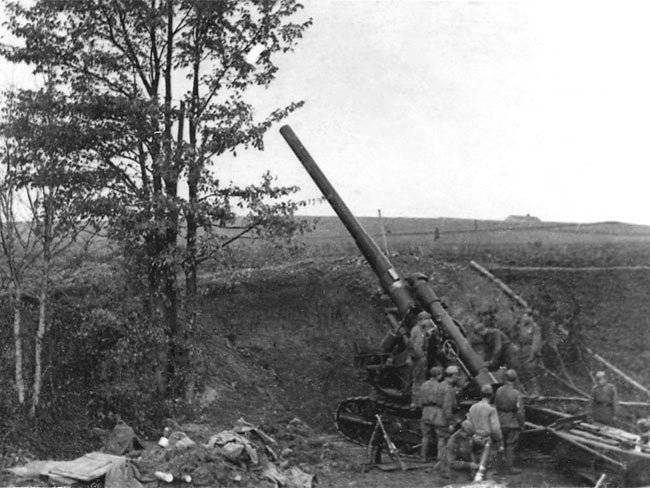
East Prussia. Autumn 1944
German troops had in East Prussia, as the ancient, medieval fortifications, and relatively new, the times of the First World War. After the defeat of Germany in the 1914-1918 war. Entente powers forced Berlin to destroy the defensive lines in the west, but they were allowed to keep them in East Prussia. As a result, the old fortifications were not only preserved, but also significantly expanded. From 1922, the Germans resumed work on the equipment of fortifications in East Prussia and continued them until the 1941 year.
In the 1943 year, having suffered crushing defeats at Stalingrad and at the Kursk Bulge, the German command launched work in the border area to improve the old and build new defensive lines. As the situation on the Eastern Front deteriorated and Soviet troops approached the borders of the Third Reich, this work was even more active. For the equipment of defensive lines used as field troops and a special construction organization Todt, and the local population and prisoners of war (up to 150 thousand people).
When building fortifications, German engineers skillfully took into account the terrain features. All the main defensive lines, which were located one from the other on 15-20 km, tried to equip the crests of the dominant heights, the banks of water bodies, ravines and other natural obstacles. All the main settlements were prepared for the circular defense. Fortifications covered the rubble, anti-tank and anti-personnel barriers, minefields. Thus, the average mining density was 1500-2000 mines per 1 km of front. The defense was created in such a way that with the loss of one line, the Wehrmacht could immediately gain a foothold on the other, and the Soviet troops had to organize an assault on the defensive line.
In the offensive zone of the 3 of the Byelorussian Front there were three fortifications - Ilmenhorst, Heilsberg, Lettsensky, as well as the Koenigsberg fortress. In total, on the approaches to Konigsberg, there are nine fortified lanes, with a depth of 150 km. Immediately before the state border, German troops equipped an additional field type fortification with a total depth of 16 - 20 km, which consisted of one main and two intermediate defensive lines. It was a kind of predpole of the defensive zone of East Prussia. The additional strip was supposed to wear down and exsanguinate the Soviet troops so that they could be stopped on the main line.
The frontier defense zone consisted of two defensive lines with a total depth of 6-10 km. The most powerful defense was on the Stallupensky-Gumbinnen direction, near the Kaunas-Insterburg road. So, here only on the 18-kilometer section of the Germans had 59 reinforced concrete structures (24 dota, 29 shelters and 6 command and observation posts). The cities of Stallupenen, Gumbinnen, Goldap, Darkemen and some large villages were turned into serious centers of resistance. The German Führer repeatedly personally visited the defensive lines in East Prussia, raising the morale of the soldiers. Virtually all of East Prussia was turned into one huge fortified area.
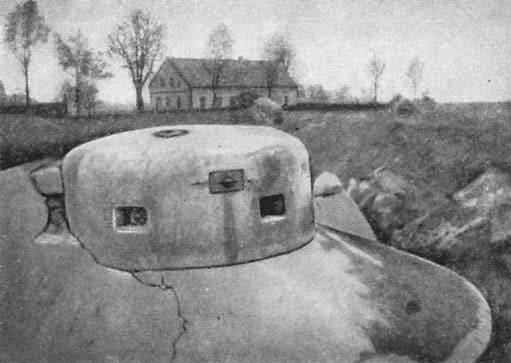
Cap of three-amusement dota
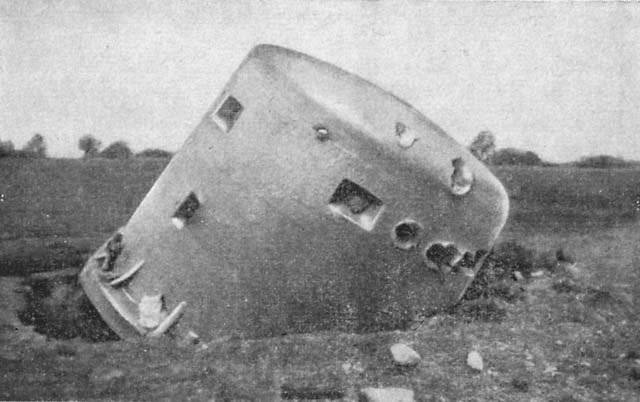
Dot with three holes
Operation plan and its preparation
The exit of the Soviet troops in the central direction to the Narew and Vistula rivers by mid-September 1944 created the conditions for an offensive along the shortest Warsaw direction to the most important centers of the Third Reich. However, for this it was necessary not only to break the resistance of significant enemy forces, but also to solve the problem of the Wehrmacht’s East Prussian grouping. In order to improve the possibilities of attacking the Warsaw-Berlin sector, the Supreme Command decided to conduct an operation in East Prussia to weaken the enemy’s forces in the Warsaw sector, drawing German reserves to the Tilsit-Königsberg sector from there, and taking Koenigsberg, Germany’s most important stronghold east.
October 3 1944 of the Year The Stake ordered the command of the 3 of the Belarusian Front to prepare and conduct an offensive operation with the aim of defeating the Weilmacht tilsit-Insterburg group and seizing Koenigsberg. By the outbreak of hostilities, the 3 of the Byelorussian Front had 6 armies (including one air). Total about 400 thousand people. Directly on the point of impact were the troops of three armies (5, 11, Guards and 28).
The adjacent flanks of the 5 and 11 Guards armies from the Vilkaviskis area to Stallupenen, Gumbinnen, Insterburg and further to Konigsberg were to deliver the main blow. On the 8-10 day of the operation, Soviet troops planned to reach the Insterburg-Darkman-Goldap line. Then the troops of the two armies were to attack Allenburg and Preis-Eylau, and also to allocate forces for an offensive from the south to Königsberg. 28-I army was in the second echelon of the front. The 39 Army was supposed to reinforce the main attack on the front right wing, and the 31 Army was the left wing.
By the decision of the commander of the 3 Belorussian Front of Chernyakhovsky, an assault group of 5, 11 of the Guards and 28 armies (27 divisions) struck at the front of the 22-24 km. This made it possible to create artillery density of 200-220 barrels and at least 25-30 tanks on the 1 km of front. After breaking through the enemy defenses and defeating the main forces of the left wing of the 4 of the German army, the Soviet troops were to take Insterburg in cooperation with the forces of the 39 and 31 armies and advance into Preis-Eylau area. Further, in cooperation with the forces of the 1 of the Baltic Front, they planned to seize Königsberg. In the second echelon of the front, in addition to the connections of the 28 Army, there was a 2-th separate Guards Tankin Tank Corps. By October 14, the front forces were to complete preparations for the operation.
Thus, from the very beginning, the plan of operation had weak points. The forces of one front could not destroy the defense of the vast East Prussian fortified area. The plan for the Gumbinnen-Goldapa operation was reduced to one main strike in the Gumbinnen direction. The German command was expecting a strike in this direction; here the main defensive fortifications of the Wehrmacht were located. Already on October 14, the German command began to take measures to strengthen the defense in the Gumbinnen direction. A strike in this direction led to excessive losses in people and equipment, to the loss of the pace of the offensive. The flanking armies, the 39 and 31, had an excessive number of troops for an auxiliary offensive. The front command abandoned concentric strikes in order to surround the enemy in its operational defense zone. In general, the front experienced a shortage of mobile formations necessary for the development of an offensive after a breakthrough of enemy defenses, tanks and artillery of large calibers.
The beginning of the operation. Breakthrough border defense
Starting from 10-12 in October, the troops of the 3 of the Belorussian Front began to take the lead. The command, the headquarters occupied the advanced command and observation posts, the artillery - the areas of firing positions. The initial position occupied the divisions of the first and second echelons and tank units. The main role in the breakthrough of the German defense was to play 11-I Guards Army.
On the night of October 16, the Soviet aviation began to strike at enemy strongholds, its firing positions. At the same time, search groups of first-tier divisions clarified the enemy’s position at the front line of defense and captured “languages”. The first to engage in battle were reconnaissance units of advanced divisions. They found that the German command did not withdraw troops, and the soldiers still occupy the main defense zone and are concentrated mainly in the second and third lines of trenches. Additional enemy firing points were discovered. The German command, guessing the beginning of the Soviet offensive, responded with shelling of Soviet positions.
October 16 1944 of the year at 9 hour. 30 min. artillery preparation began. The main forces of artillery were concentrated in the breakthrough areas of the 11 Guards and 5 Army under the command of Kuzma Galytsky and Nikolay Krylov. First, the enemy positions covered a volley of Guards mortars, then all the artillery opened fire. Army artillery fired at depths of up to 5 km, and long-range artillery struck depths of up to 10 km. After the 70-minute continuous fire, artillery moved the fire into the depths of the enemy defense. The guns, which were put on a direct lead, continued to fire at enemy positions at the forefront. At 11, the final stage of the artillery preparation began. Again the focus of the gunners was on the frontline of the German defense. The artillery fire supplemented the crushing blow of the airplanes of the 1 Air Force under the command of Timofey Khryukin.
In 11 hours, infantry and tanks launched an offensive. The troops followed the firing shaft and their attack aircraft supported them from the air. Due to the morning fog, visibility was limited, so part of the enemy’s firing positions survived. German guns, mortars and machine guns opened a quick fire on the battle formations of the advancing troops of the first echelon. Therefore, the remaining firing positions of the enemy had to be subjected to additional artillery and air strikes. The battle immediately took an extremely stubborn and protracted nature. The Germans stubbornly resisted.
The advanced divisions of the 11 Guards Army, breaking through the first and second trench lines, rushed to the third, where the main enemy forces were located. Here the Germans had a significant number of artillery batteries, including anti-tank guns, and in every way tried to prevent the breakthrough of the Soviet troops in the depth of their defense. However, in the 12 hour. 30 min. Soviet troops occupied the third line of trenches. A major role in the breakthrough of the German defense tank units played.
Further offensive stalled. Parts of the 549 th and 561 th infantry divisions of the enemy, who occupied the defense in the first echelon, retreated to the intermediate line, where regimental and divisional reserves were already deployed. At the same time, tanks, assault guns and anti-tank artillery were pulled from the depths of the German defense. Having taken pre-prepared and well-disguised positions, the German troops gave a powerful rebuff to the advancing Soviet units. They also successfully used tank and artillery ambushes to fight Soviet armored vehicles. Therefore, the divisions of the Soviet 153 Tank Brigade suffered serious losses. Attacks rifle units also choked. The German command pulled up additional infantry units and a tank battalion to the place of the planned breakthrough. At the same time, the Germans regrouped field artillery, and it began to support its troops from the depths of the defense. Activated and German aircraft.
The Soviet command organized an air strike. In 13 hour. 30 min. units of the 26 and 31 divisions attacked the 153 brigade, supported by two regiments of SAU and ground attack aircraft. However, the Soviet troops suffered heavy losses and could not break through the German defense. In addition, the Germans organized several strong counterattacks. The German command tried to stop the offensive of the Soviet troops at any cost and continued to introduce new forces into the battle. Only after entering into battle the second echelons of corps the offensive was continued.
The 15 army of Galitsky advanced 11-4 km in depth and to 6-10 km along the front by 13 clock. The Germans continued to fiercely resist, but were forced to retreat to new positions. The German command, having determined the place of the breakthrough, threw additional forces into the battle area and began to prepare a counterattack. The command of the 11-th Guards Army, in order to maintain the pace of the offensive, brought the army mobile group into battle - the 1-th Guards Rifle Division and the 213-th tank brigade. The beginning of its offensive was supported by artillery and air strikes. The Germans responded with strong counterattacks. The 213 Brigade suffered heavy losses. Thus, during a fierce battle, the brigade commander, Colonel M. M. Klimenko, the commanders of the 1 and 2 battalions, captains G. P. Sergeichuk and N. A. Kurbatov fell. In the 2 battalion, all the commanders of the company fell to the death of the brave. 1-I Guards Division also could not have a significant impact on the development of the offensive. The command of the division lost control of the battle, artillery lagged behind. Infantry without the support of artillery and tanks could not develop the offensive.
In a day of heavy fighting, the Galitsky army broke through the enemy front at the 10 km section and advanced into the depths of its defense at 8-10 km. The main line of defense of the enemy was overcome. However, the Soviet troops could not violate the operational integrity of the German defense. The German command quickly redeployed reserves, consolidated their battle formations on the main line, regrouped artillery and organized strong counterattacks. In fact, the Soviet troops were forced to attack the enemy’s strong positions in the head, gnaw through its defenses meter by meter, organize storming of new fortified lines and strong points. The Germans were crowded, but could not inflict a decisive defeat on them.
October 17 The 11-I Guards Army, beating off fierce enemy counterattacks (the German command pulled up additional forces, including the 103-I tank brigade and the Norway battalion), stormed the heavily reinforced Virbalis defense center. By the end of the day, the troops of the Galitsky army in the center and on the left flank broke through the second intermediate line of the enemy’s defense and advanced 16 km. The right flank of the army advanced 14 km. In just two days, the army expanded the breakthrough to 30 km. The German command responded to the successes of the Soviet troops by the fact that the emerging Herman Göring tank corps of 17 in October received the task of reaching the area in the Gumbinnen area (the first units began to deploy October 14).
The neighboring 5 Army also launched the October 16 offensive, broke through the enemy defenses on the 10-kilometer stretch, and in two days of heavy fighting advanced 10-16 kilometers. October 17 went on the offensive 31-I army. She for the day of fights advanced on 8 km.
On October 18, the troops of the 11-I Guards Army, continuing to carry out heavy battles with enemy forces and repel numerous counterattacks, in the evening took a large stronghold of Kybartai and broke through the border line of the enemy’s defense, entering the territory of East Prussia. During the day, the Galician army moved west to 6-8 km and reached the German line of defense along the Pissa River. Thus, for three days of intense battle, the 11-I Guards Army formations advanced in depth by 22-30 km, the breakthrough front reached 35 km. Army troops broke through the main and two intermediate lines of enemy defenses. Neighboring 5-I and 31-I army advanced to 18-15 km by the end of October 28. At this point, the first stage of the Gumbinnen-Goldapa operation was completed.
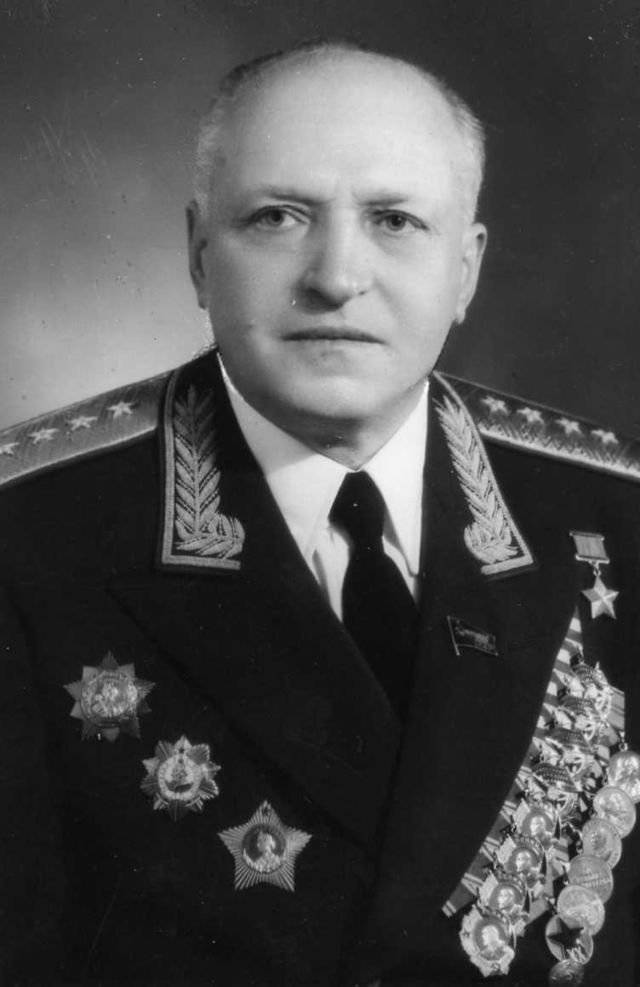
Commander 11-th Guards Army Kuzma Nikitovich Galitsky
To be continued ...
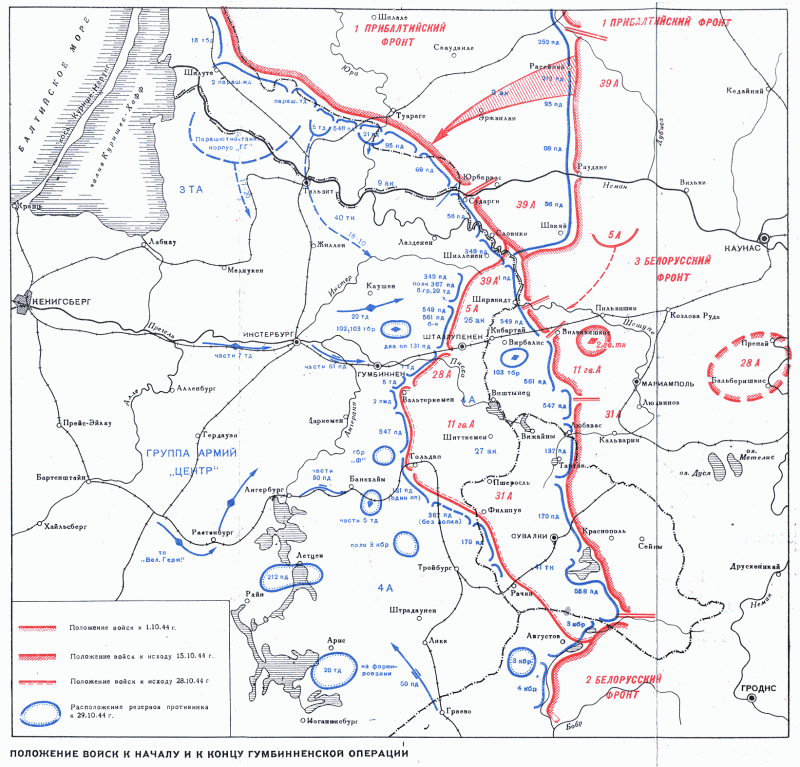
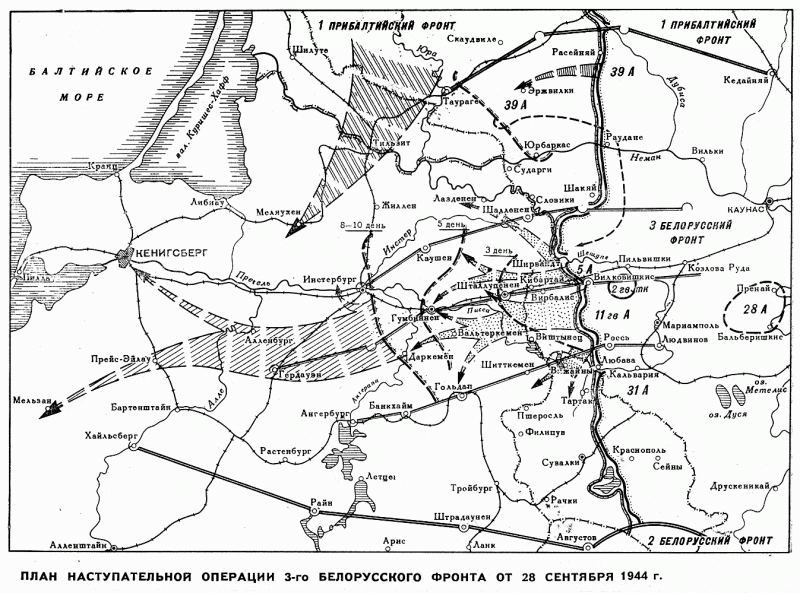
Information